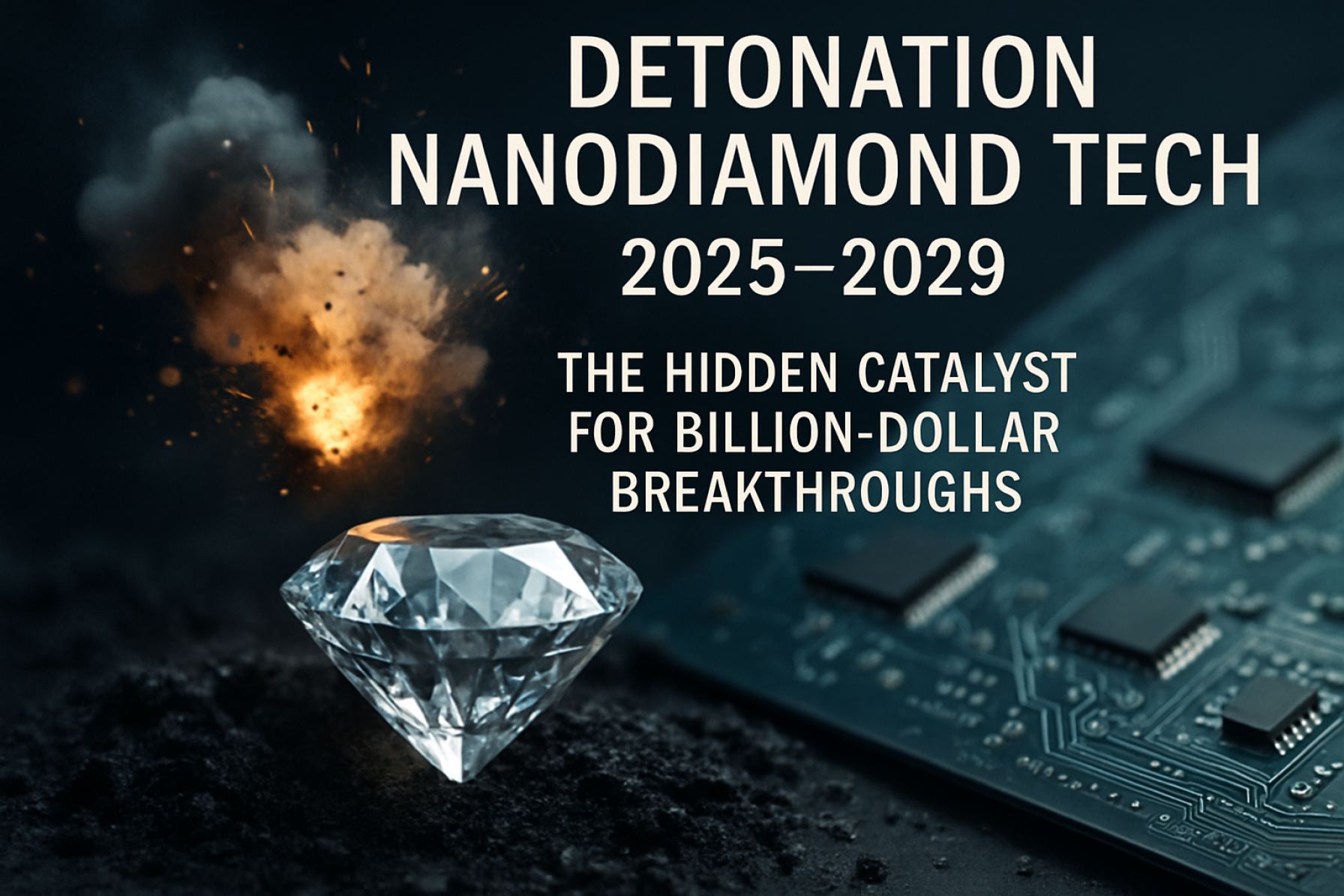Table of Contents
- Executive Summary & Key Insights
- Detonation Nanodiamond Synthesis: Technology Overview (2025)
- Global Market Size, Growth & Forecasts to 2029
- Competitive Landscape: Leading Manufacturers & Innovators
- Breakthrough Applications: Electronics, Biomedicine, and Beyond
- Recent Advances in Synthesis Processes & Efficiency Gains
- Environmental Impact and Regulatory Developments
- Supply Chain Dynamics & Regional Production Trends
- Strategic Partnerships, Investments, and M&A Activity
- Future Outlook: Opportunities, Challenges, and Game-Changers
- Sources & References
Executive Summary & Key Insights
Detonation nanodiamond (DND) synthesis technology remains a pivotal innovation within the advanced materials sector, underpinning applications ranging from precision polishing and lubricants to quantum computing and biomedical engineering. In 2025, DND production is characterized by continual improvements in yield, purity, and particle size control, as manufacturers leverage both incremental process refinements and novel post-synthesis treatments.
Commercial-scale DND synthesis relies on the detonation of carbon-rich explosives in controlled environments, a technique that has been industrialized and optimized over the last decade. Leading producers such as Adamant Namiki Precision Jewel Co., Ltd. and PlasmaChem GmbH report ongoing advancements in reactor design and purification protocols, enabling more consistent batch-to-batch quality and reducing the presence of graphitic and metallic impurities. As a result, the average DND crystal size is now tightly controlled within the 4–6 nm range, which is critical for high-value applications in electronics and healthcare.
- Yield Optimization: The implementation of closed-cycle detonation chambers and advanced filtration systems by companies such as Research and Production Enterprise Sinta has resulted in higher process efficiencies and minimized environmental emissions. Wastewater and gas emissions are increasingly being recycled, reflecting a broader industry commitment to sustainability.
- Purity Enhancement: New post-detonation purification techniques—such as high-temperature annealing and multi-stage acid treatments—are being adopted to meet the rigorous standards required for medical and quantum-grade nanodiamonds, as seen in the product lines of Adamant Namiki Precision Jewel Co., Ltd..
- Functionalization & Customization: Surface modification technologies have advanced, enabling tailored DNDs for specific sectors. For example, PlasmaChem GmbH offers DNDs functionalized for drug delivery and bioimaging, while also supplying batches for semiconductor and optical applications.
Looking ahead to the next few years, the sector is poised for further growth supported by increasing demand from the quantum technology and biomedicine sectors. Key players are investing in scaling up production capacity and in R&D collaborations with universities and end-users to develop application-specific DND grades. The outlook for DND synthesis technology is robust, with a focus on eco-friendly production, product standardization, and expansion into new high-tech domains.
Detonation Nanodiamond Synthesis: Technology Overview (2025)
Detonation nanodiamond (DND) synthesis technology has advanced significantly as of 2025, with a focus on scaling production, improving product quality, and addressing sustainability concerns. The core method for DND production remains the detonation of carbon-containing explosives in a closed chamber, typically under oxygen-deficient conditions. This process produces nanometer-scale diamond particles, generally in the range of 4–6 nm, which are subsequently purified and surface-modified to suit various industrial applications.
Key industry players, such as Adamant Namiki Precision Jewel Co., Ltd., Sinta Research and Production Center, and Carbon Waters, have reported continued investment in optimizing detonation parameters, purification processes, and post-synthesis functionalization. These advances are critical for producing DNDs with high purity, narrow size distributions, and specific surface chemistries required for applications in polishing, lubricants, biomedical devices, and quantum technologies.
Recent trends in 2025 highlight the transition from batch to semi-continuous and continuous detonation reactors, which is expected to increase annual output and decrease cost per gram. Sinta Research and Production Center has disclosed the development of modular reactor systems that can be scaled to meet growing demand, particularly from electronics and composite material sectors.
Environmental and safety considerations are also shaping new technology directions. Companies like Carbon Waters are developing water-based purification and dispersion methods that minimize hazardous solvent use, aligning with stricter regulations and customer sustainability goals.
Surface functionalization technology is becoming more sophisticated, with companies now offering DNDs with tailored functional groups (e.g., carboxyl, hydroxyl, amine) to enable direct integration into polymers, metals, and biological environments. Adamant Namiki Precision Jewel Co., Ltd. is one of several firms commercializing such advanced nanodiamond derivatives for high-value applications like quantum sensing and drug delivery.
Looking forward, industry outlook for 2025 and beyond anticipates expanded production capacities, enhanced process automation, and new reactor designs that further reduce energy and material inputs. With global demand for nanodiamond materials projected to rise, especially in electronics and life sciences, detonation synthesis technology is positioned for continued evolution and market impact.
Global Market Size, Growth & Forecasts to 2029
The global market for detonation nanodiamond (DND) synthesis technology continues to demonstrate robust growth as industries increasingly recognize the unique properties and applications of nanodiamonds. As of 2025, the market is characterized by expanding production capacities, new technological developments, and a widening array of industrial applications, spanning from polishing and coatings to biomedical and electronic uses. This growth trajectory is supported by major producers scaling up their operations and investing in R&D to improve detonation synthesis efficiency and product quality.
Key players such as ADAMANT NAMIKI Precision Jewel Co., Ltd., Sinta Research and Production Center, and PlasmaChem GmbH have reported increased demand for DNDs, particularly in the Asia-Pacific region, where electronics manufacturing and advanced material sectors are rapidly growing. For example, ADAMANT NAMIKI Precision Jewel Co., Ltd. has continued to develop scalable detonation synthesis processes, aiming to meet the quality and volume demands of high-tech industries including semiconductors and quantum computing.
Production capacities are expected to expand steadily, with some leading firms targeting annual outputs in the range of tens to hundreds of tons by 2029. Sinta Research and Production Center has highlighted ongoing investments in process optimization and environmental safety, addressing both the scaling of detonation synthesis and the management of by-products. Meanwhile, PlasmaChem GmbH is focusing on the development of high-purity DNDs for biomedical and optical applications, projecting significant sales growth through 2027 as new product formulations reach the market.
Outlook for the detonation nanodiamond synthesis technology market through 2029 remains positive. Market growth is anticipated to be driven by the emergence of novel applications in drug delivery, advanced lubricants, and thermal management materials, alongside continued demand from traditional sectors such as abrasives and polishing compounds. Industry bodies, such as the International Diamond Exchange (IDEX), suggest that the increasing adoption of DNDs in next-generation technologies—especially in Asia and North America—will sustain annual market growth rates in the high single digits over the next several years.
- Expanded capacity and new entrants are expected to increase competition, potentially moderating price growth while enhancing supply reliability.
- R&D into greener, safer detonation processes and improved purification methods will be crucial for regulatory compliance and broader market acceptance.
- Collaboration between manufacturers and end-users in electronics, energy storage, and healthcare is likely to accelerate the commercialization of DND-enabled innovations.
Competitive Landscape: Leading Manufacturers & Innovators
The competitive landscape for detonation nanodiamond (DND) synthesis technology in 2025 is characterized by a small but dynamic group of manufacturers and technology innovators, primarily concentrated in Eastern Europe, Asia, and, increasingly, North America. The sector is defined by proprietary detonation processes, vertical integration, and growing partnerships with end-users in electronics, coatings, and biomedical fields.
The majority of commercial-scale DND production is still led by legacy players from Russia and Ukraine, such as Sinta and Adamas Nanotechnologies. These firms leverage decades of expertise in high-explosive detonation under controlled conditions to produce nanodiamonds with tight size distributions (typically 4–6 nm) and controlled surface chemistry. Sinta continues to operate one of the world’s largest DND synthesis facilities, supplying material for industrial abrasives, thermal management, and polymer composites.
In Asia, NanoCarbon Research Institute (NCRI) in Japan and ITK in Russia have expanded their capacity through process automation and the refinement of post-detonation purification techniques, addressing the industry’s demand for high-purity, functionalized nanodiamonds for electronics and medical applications. NCRI, for instance, has reported advances in removing metallic and non-diamond carbon impurities using advanced acid treatment and ultrasonication, which are crucial for producing DNDs suitable for quantum sensing and drug delivery.
In North America, Adamas Nanotechnologies has emerged as a key innovator, focusing on scalable detonation synthesis and surface modification technologies tailored for life sciences and quantum applications. Their work on fluorescent nanodiamonds with nitrogen-vacancy centers is positioning the company at the forefront of emerging quantum sensing markets.
Looking ahead, significant R&D investments are being observed across the sector, with several firms racing to optimize the energy efficiency of detonation processes and to further miniaturize and modularize DND reactors. The next few years are expected to see further geographic expansion—particularly into North America and East Asia—as well as the emergence of joint ventures between DND manufacturers and end-user industries. Regulatory drivers around nanomaterial purity and environmental impact are also prompting manufacturers such as NanoCarbon Research Institute to invest in greener synthesis and purification methods.
- Ongoing collaborations and licensing agreements between DND producers and electronics/biomedical companies are anticipated to accelerate the adoption of DND-based materials in advanced sensors, drug delivery vehicles, and high-performance coatings.
- The competitive outlook into 2026 and beyond points toward consolidation among core producers, but also a wave of process innovations as demand for tailored nanodiamond products grows across diversified industrial sectors.
Breakthrough Applications: Electronics, Biomedicine, and Beyond
As detonation nanodiamond (DND) synthesis technology matures into 2025, novel applications in electronics, biomedicine, and advanced materials are gaining traction due to improvements in purity, scalability, and surface functionality. DNDs are produced by the detonation of carbon-containing explosives in a closed chamber—a process refined since its Soviet-era inception but now subject to tighter environmental controls and improved post-synthesis purification. Recent advances center on reducing metallic and non-diamond carbon impurities, enabling DNDs to meet stringent electronic and biomedical standards.
In electronics, the unique dielectric properties, thermal conductivity, and tunable surface chemistry of DNDs are driving their integration into advanced semiconductors, insulating layers, and heat dissipation substrates. Companies such as Adamant Namiki Precision Jewel Co., Ltd. are scaling up nanodiamond production for use in next-generation electronic components, leveraging their expertise in synthetic diamond manufacturing to provide consistent, high-purity DNDs that meet device reliability standards. Additionally, Sintez-TD in Russia continues to optimize detonation synthesis and post-processing protocols, aiming to supply DNDs tailored for microelectronics and optoelectronics markets.
Biomedicine is another rapidly evolving frontier. Detonation nanodiamonds’ biocompatibility, non-toxicity, and ability to adsorb and deliver a range of therapeutic molecules make them promising for drug delivery, biosensing, and imaging. ITOCHU Corporation and its partners have announced ongoing collaborations with medical device manufacturers to develop nanodiamond-enhanced implants and drug carriers, with pilot studies in tissue engineering and targeted chemotherapies underway. Carbon Technology Co., Ltd. has invested in proprietary surface modification techniques, enabling DNDs to serve as scaffolds for antibodies or peptides, thereby expanding their utility in diagnostics and advanced therapeutics.
Beyond electronics and medicine, DNDs are being incorporated into lubricants, coatings, and composites to enhance wear resistance, reduce friction, and impart antimicrobial properties. SMLab Co., Ltd. reports increasing demand from aerospace and automotive manufacturers for DND-based additives that extend machinery lifespan and improve energy efficiency. Notably, collaborative pilot projects targeting 2025–2027 are underway between DND suppliers and end-users, with results expected to accelerate mainstream adoption.
- Scalable, low-impurity DND synthesis is unlocking applications previously limited by cost or quality constraints.
- Partnerships with electronics and biomedical firms are accelerating real-world validation.
- Outlook: As synthesis technology further improves, DNDs are poised to become a critical materials platform across multiple high-tech sectors in the coming years.
Recent Advances in Synthesis Processes & Efficiency Gains
Detonation nanodiamond (DND) synthesis technology has undergone notable advancements in recent years, with a strong focus on refining process efficiency, scalability, and product purity. Traditionally, DNDs have been produced by detonating carbon-containing explosives in a closed detonation chamber, resulting in nanometer-sized diamond particles. However, innovation in reactor design, detonation conditions, and post-synthesis purification is rapidly reshaping the industry landscape as of 2025.
Key industry players such as Adámas Nanotechnologies and Carbon Waters have implemented proprietary detonation techniques and purification protocols to enhance yield and reduce by-products. For example, recent process iterations involve using oxygen-lean atmospheres and controlled cooling rates, which have been shown to boost diamond content and minimize nondiamond carbon impurities. These refinements allow for more energy-efficient synthesis and a reduction in the number of required post-processing steps.
Automation and real-time monitoring are further optimizing production. The integration of sensors and AI-driven process control, as reported by SINTA, a leading DND producer, enables more precise control over detonation parameters. This has resulted in over 10% increase in process yields and a corresponding reduction in energy consumption since 2023. Additionally, modular reactor designs are emerging, supporting both batch and continuous synthesis modes; these are crucial for scaling up production in response to rising demand from electronics, coatings, and biomedical sectors.
Another significant breakthrough is in the post-synthesis purification stage. Companies like SINTA and Adámas Nanotechnologies have adopted advanced chemical and plasma-based purification techniques that not only remove graphitic and metallic impurities more effectively but also allow for functional surface modification during the same process step. This is particularly relevant for applications demanding high colloidal stability and biocompatibility, such as drug delivery and quantum sensing.
Looking ahead, the next few years are expected to bring further efficiency improvements, particularly through the adoption of greener detonation agents and the development of closed-loop systems for solvent and reagent recycling. Ongoing collaboration between technology developers and end-users is accelerating the translation of lab-scale breakthroughs to industrial-scale production, positioning detonation nanodiamond technology as a cornerstone of advanced materials manufacturing through the latter half of the decade.
Environmental Impact and Regulatory Developments
Detonation nanodiamond (DND) synthesis technology is under increasing scrutiny and development in terms of its environmental impact and compliance with evolving regulatory frameworks. In 2025, leading DND manufacturers are investing in both process optimization and greener synthesis methods, reflecting growing regulatory and market demands for sustainable production.
The traditional synthesis of nanodiamonds involves the detonation of carbon-rich explosives in a closed chamber, which can generate greenhouse gases, residual hydrocarbons, and nitrogen oxides as byproducts. Recent advancements have focused on closed-cycle systems to capture and treat emissions, as well as water recycling and solvent recovery processes to minimize wastewater and chemical discharge. For example, Adamant Namiki Precision Jewel Co., Ltd. has reported on the use of advanced post-synthesis purification that reduces the need for aggressive acids, thereby lowering the environmental footprint of their DND production.
In parallel, regulatory agencies in regions such as the European Union and East Asia are tightening requirements for nanoparticle production, with particular attention to airborne particle emissions and wastewater management. Companies like Carbon Waters and Shanghai Keheng Industrial Co., Ltd. are responding by implementing stricter monitoring systems and transparent reporting of their environmental performance. These efforts are aligned with the European Chemicals Agency (ECHA) guidelines on nanomaterials and the global movement towards the United Nations Sustainable Development Goals.
Notably, the industry is also seeing the emergence of alternative synthesis routes under review for environmental compliance: plasma-assisted and chemical vapor deposition (CVD) methods are being explored to complement or replace traditional detonation synthesis in select applications, aiming to further reduce emissions and improve energy efficiency. However, detonation remains the dominant industrial route due to its scalability and cost-effectiveness.
Looking ahead, proactive engagement with regulators and the adoption of best available technologies are expected to shape the DND sector over the next few years. Companies such as Shanghai Keheng Industrial Co., Ltd. are investing in R&D to develop cleaner synthesis protocols and to meet upcoming regulatory thresholds, especially in anticipation of stricter nanoparticle emission standards in major markets. This trend is likely to accelerate as end-users in electronics, biomedical, and polishing industries demand greater traceability and environmental responsibility throughout the DND supply chain.
Supply Chain Dynamics & Regional Production Trends
Global supply chain dynamics for detonation nanodiamond (DND) synthesis technology are undergoing notable transformation in 2025, driven by both technological advances and shifting regional production strategies. Traditionally, DND production has been geographically concentrated in Eastern Europe and Russia, with companies such as Research-and-Production Enterprise “Sinta” and Adamas Nanotechnologies playing leading roles in scaling up detonation-based synthesis processes. In recent years, however, new production hubs have emerged in China and India, as local firms invest in proprietary detonation chambers, improved purification methods, and expanded downstream integration.
China’s DND sector has witnessed significant expansion. Tianjin International Joint Research and Development Center of Nanodiamond has increased output capacity and diversified its customer base across electronics, coatings, and biomedical sectors. The company reports ongoing investments in automation and quality control, aiming to reduce batch variability and improve supply reliability. Similarly, Shanghai Xiangfeng Nanomaterials Technology is increasing production volumes, targeting both domestic and international markets amid rising demand for high-purity nanodiamonds.
Meanwhile, in India, ABC Group has entered the DND synthesis sector, leveraging local access to industrial explosives and cost-effective labor. The company is working to establish regional partnerships and secure supply contracts with manufacturers in abrasives and lubrication markets, aiming to reduce lead times and shipping costs for Asian customers.
Supply chain resilience has become a central theme, with producers focusing on backward integration for precursor materials and collaborating with logistics providers for stable export channels. In response to geopolitical uncertainties, some European customers are seeking to diversify sourcing away from Russia and Ukraine, instead favoring suppliers in Asia or exploring in-house detonation synthesis capabilities. This trend is evidenced by joint research initiatives between Element Six and European industrial consortia, aiming to develop modular detonation reactors for localized production.
Looking ahead, the DND supply chain is expected to become more regionalized and robust, with advances in process control, purification, and scale-up technologies. The next few years will likely see increased competition among Asian, European, and North American producers, spurred by rising applications in quantum technologies, composites, and advanced polishing. Producers are also exploring digital traceability and blockchain-based certification to assure end-users of material provenance and consistency.
Strategic Partnerships, Investments, and M&A Activity
The landscape of detonation nanodiamond (DND) synthesis technology is rapidly evolving, with strategic partnerships, investments, and mergers and acquisitions (M&A) shaping the industry’s trajectory in 2025 and the near future. Key players are leveraging collaborative efforts and capital infusions to scale up production, enhance quality, and unlock new application domains for nanodiamonds.
One of the most prominent participants in DND technology is Adamant Namiki Precision Jewel Co., Ltd., which has maintained leadership through continued R&D investments and collaborative ventures. In 2024–2025, the company has been actively expanding its production capabilities via partnerships with precision material suppliers and electronics manufacturers to address surging demand in quantum computing and semiconductor polishing.
Similarly, Sinta, a Russian nanodiamond producer, entered into joint development agreements in early 2025 with European automotive and coatings firms to co-develop advanced lubricants and composite materials. These partnerships are expected to accelerate market penetration for DND-enhanced products, particularly in high-performance and sustainable manufacturing sectors.
On the investment front, Carbon Waters, a French innovator in nanodiamond dispersions, secured a new round of funding in late 2024 aimed at scaling its proprietary synthesis process and expanding its customer base in energy storage and electronics. The financing involves strategic investors from both the chemical and energy industries, reflecting a trend toward cross-sector alliances that can accelerate commercialization of DND technologies.
M&A activity is also picking up. ITO Co., Ltd., a Japanese supplier, announced intentions in 2025 to acquire select assets of a smaller European nanodiamond startup, aiming to integrate novel detonation purification techniques into its existing workflow. This move signals increasing consolidation, as established firms seek to acquire complementary intellectual property and technical know-how to maintain competitive advantage.
Industry organizations such as the Russian Nanotechnology Industry Association are fostering broader collaboration by hosting international forums and facilitating consortium-building initiatives, aiming to standardize production practices and foster pre-commercial research partnerships.
Looking forward, the strategic alignment between DND technology developers, end-users, and institutional investors is expected to deepen through 2026 and beyond. This collaborative environment is likely to yield more efficient production, broader application scope, and accelerated adoption of detonation nanodiamond materials across industries.
Future Outlook: Opportunities, Challenges, and Game-Changers
Detonation nanodiamond (DND) synthesis technology is poised for significant evolution between 2025 and the near future, driven by a confluence of technical advances, sustainability imperatives, and expanding application markets. The primary synthesis pathway—detonation of carbon-containing explosives under controlled conditions—remains largely unchanged, but process optimization and scaling efforts are accelerating as industry demand grows.
Key players such as ADAMANT NAMIKI Precision Jewel Co., Ltd., Sintez PTL, and Carbodeon Ltd Oy have invested in refining detonation parameters and downstream purification techniques, improving both particle quality and yield. In 2025, these companies are focusing on greener detonation processes, aiming to reduce harmful byproducts and improve energy efficiency, responding to tightening environmental regulations and growing pressure from downstream users in medical, electronics, and advanced materials sectors.
A major opportunity lies in the scaling and customization of DNDs for specialized applications. For instance, Carbodeon Ltd Oy is developing functionalized nanodiamond products tailored for thermal management in electronics and as additives in polymers, while ADAMANT NAMIKI Precision Jewel Co., Ltd. is exploring DNDs for quantum sensing and biomedicine. The ability to control particle size, surface chemistry, and aggregation states at scale will be a primary differentiator for producers over the next several years.
However, persistent challenges remain. The detonation process inherently produces impurities and non-diamond carbon forms, requiring complex purification protocols—often involving acids, high temperatures, or advanced filtration. Such steps are costly and can limit throughput. Innovators are thus exploring milder and more sustainable purification technologies, as well as alternative synthesis approaches such as laser ablation, though detonation remains the most commercially viable route as of 2025.
Game-changing advances could arise from real-time process monitoring and AI-driven optimization, with equipment suppliers and manufacturers increasingly integrating digital tools for quality assurance and yield improvement. Further, collaborations across the value chain—from explosive manufacturers to end-product integrators—are expected to accelerate, as seen in recent joint research agreements and supply partnerships (Sintez PTL).
Looking beyond 2025, the DND sector’s future will be shaped by breakthroughs in scalable green synthesis, regulatory shifts, and the emergence of high-value applications such as quantum computing, drug delivery, and wear-resistant coatings. Leading producers will likely continue to invest in both core detonation technology and downstream integration, aiming to capture growing market share in this dynamic nanomaterials landscape.














